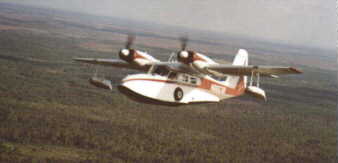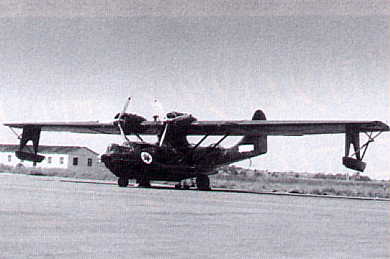
The four-seat amphibian Seabee was designed as a low cost sport airplane. Its RC-1 protoype was first flown during July 1944 and over 1,200 production RC-3s were built between 1946 and 1948 to provide for the enourmous demand for the type. There are still as many as 500 Seabees in service today, while restored examples are worth up to $60,000.
In 1946 an attorney from Tel Aviv, Shmuel Shchopak, purchased a single Seabee, one of the few private aircraft in Palestine. The Seabee (NC6731K) was assembled at Lod Airport from which it was also operated. In 1947 the Seabee joined "Aviron", one of the first airlines in Palestine, which in turn handed it to the Haganah's "Shirut Avir" (air service) in late 1947. The "Shirut Avir" operated the aircraft in its Tel Aviv squadron, out of Sde-Dov. In early 1948 the squadron commander Modi Alon attempted to land the Seabee on the nearby Mediterranean but shattered one of the wing floats. Modi Alon was subsequently removed from his position (he later became the IAF's first fighter squadron commander and scored the IAF's first two kills with an Avia S.199) while the Seabee had its other wing float removed as well, eliminating its amphibian capabilities.
On April 20th the "Air Service" was reorganized and its aircraft reallocated. The Seabee became part of the 1st "Namer" (leopard) squadron's A section at Tel Aviv. On May 15th 1948, a day after the Israeli declaration of Independence, it was damaged in an Egyptian Air Force attack on Sde-Dov but was returned to service. The Seabee was later operated by the 101st fighter squadron, alongside the IAF's first fighters, the Avia S.199 and Supermarine Spitfire. It was employed mainly on cargo and liaison flights although some reconnaissance flight might have also taken place. A shortage of parts for the aircraft finally grounded the Seabee shortly after the War of Independence. The IAF Museum at Hatzerim houses a Seabee in the colours of the 101st.
First flown in 1941, The Grumman G-44 Widgeon was a fast amphibian designed for private fliers. During World War II 15 examples were used by the U.S. Army Air Force as the OV-14, 25 by the U.S. Coast Guard and 131 by the U.S. Navy which employed the type in the anti submarine warfare role. A total of 345 examples of this 2-crew/5-seat aircraft were built.
A pair of Widgeons were donated to the fledgling IAF in 1948 by the Dutch millionaire Bernard Van Lear. The Widgeons were employed on cargo flights between IAF bases and were usually land based. On December 2nd 1948 one of the Widgeons crashed while attempting to land on the Sea of Galilee, killing the three foreign volunteers aboard. The second Widgeon was retired in 1949.

In the beginning of the 1950s a trip to the port of Eilat, at the southernmost tip of the Negev Desert (click here for map of Israel), could take more than a day to complete and went through dangerous terrain, with travellers attacked by infiltrating terrorists on a number of occasions. In order to maintain clear and permanent contact with this strategic point, Israel's only outlet to the Red Sea, 3 Consolidated PBY-5A Catalinas were purchased in 1951, easily landing in the Gulf of Aqaba. The Catalinas belonged to the 69th "Patishim" (Hammers) squadron, alongside Boeing B-17s, and were also active in the role of Maritime patrol. They were retired from service in 1954.
Specification: Consolidated PBY-5A Catalina
Type: eight/nine seat general reconnaissance flying-boat.
Powerplant: 2 Pratt & Whitney R-1830-S1C3-G Twin Wasp.
Performance: max speed - 190mph, range - 4,000 miles.
Weights: max takeoff - 12283kg.
Dimensions: span - 31.70m, length - 19.86m.
Armament: 6 * 7.7mm machine guns plus provision for up to 907kg of bombs carried under the wings.
Israel's commitment to aid Britain and France during the Suez crisis was given during October 1956 on the condition that France would provide aircraft and pilots to protect Israeli airspace and aid the IAF. Three French air force squadrons were based in Israel during the crisis, one of these, EC1, equipped with 18 F-84F Thunderstreaks. Based at Lod AFB, this squadron was assigned an Israeli number, 200, and it's aircraft carried Israeli markings. The Thunderstreaks went on a number of bombing missions inside Egyptian territory, most of the time flying defensive missions.
Specification: Republic F-84F ThunderstreakWith the continued armament of Arab air forces during the 1950s, Israel was forced to constantly look for new resources and aircraft to bolster the IAF's fighter arm. On April 1954 an IAF delegation was sent to Europe and America to search for a new fighter. The aircraft chosen was the Canadair CL-13 Sabre, the Canadian version of the North American F-86 Sabre, star of the Korean war. 24 CL-13B Sabre Mk.3 were purchased and were already painted with Israeli camouflage and covered with Israeli markings when the Canadian government cancelled the order, apparently under American pressure not to offend Arab governments.
Specification: Canadair CL-13 Sabre
 back to the IDF/AF page
back to the IDF/AF page